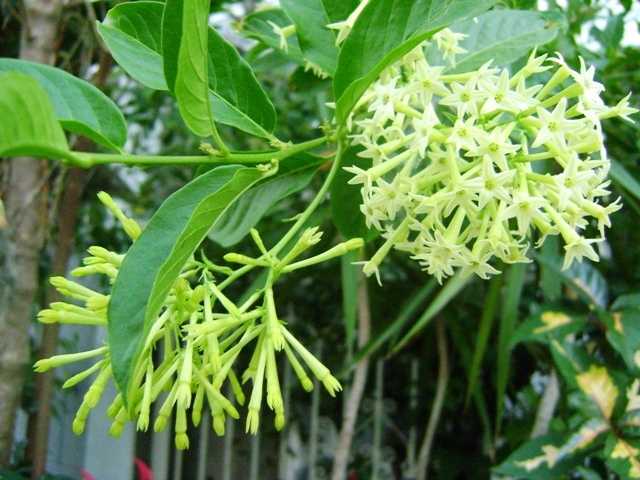Night blooming jasmine, Cestrum nocturnum, (also called night jessamine) doesn’t like the sun. This gives it an advantage to encroach upon understory bushland.

It grows well in moist deep shade and can displace native shrubs. Native to Central and South America and the West Indies, this attractive garden plant is popular in Australia and readily available in nurseries. Sadly it is another fence jumper. With a preference for wetter locations it is recorded as naturalised outside of Sydney, in the Blue Mountains, in Northern NSW and SE Qld. It has also made itself right at home on several Pacific islands, among them Hawaii, Fiji, and Tahiti.
On these islands night jasmine is known to grow in dense stands excluding all other vegetation. New Zealand also lists it as a serious environmental weed with infestations around Auckland. It has become entrenched in open woodlands, shrub lands and on creek banks. Night jasmine is a woody multi-stemmed shrub which can grow up to 4 metres high and form thickets. The stems are lanky and gracefully drooping. The long lanceolate leaves are smooth and glossy. They stink when crushed. Clusters of tubular bell flowers, 2 to 2.5 cm long, are followed by green berries which mostly turn white as they mature. Some are deep purple. Whatever the colour, each berry contains several seeds which are viable for many years. The greenish white flowers are somewhat insignificant but night jasmine is renowned for the intense heady perfume released in the evening. Peak fragrance is from dusk to midnight after which it begins to wane. It is usually recommended not to plant too close to the house as the aroma can be overpowering and be perceived more than 50 metres away from the plant. Some people are highly sensitive to this fragrance and experience irritation of nose and throat accompanied by headaches and nausea.
Asthmatics can experience respiratory distress. All parts of the plant are poisonous to people, pets and stock. A member of the nightshade family, night jasmine contains solanines in the green berries and anticholinergic glycosides in the ripe berries. The leaves contain atropine-like anticholinergic alkaloids.
Night jasmine’s cousin, green cestrum, Cestrum parqui, is well-known in paddocks and along fence lines. It looks similar and also has smelly leaves when crushed but its flowers do not produce the aromatic fragrance. It’s also responsible for stock deaths. Traditional uses of night jasmine include funeral rites. The Mayan say the Lord of Death, Kisin, was born from its flowers. Night jasmine is used in Mexican traditional medicine and shamanic practices in Nepal. In India it is cultivated for the perfume industry and used medicinally in treatments of a range of conditions. ‘Raat ki Rani’ is the Hindi name.
Choose wisely what to plant on a bush block. This shrub will spread readily via seed into nearby forest. As with many introduced species, native birds eat the berries. They carry seeds to new locations and deposit them with a little package of fertiliser ensuring they have a good start in life. Ensure all roots are removed when managing as small pieces will reshoot. If you have night jasmine in your garden, after flowering simply remove the berries before the birds get them and carry them further afield. Do not dump garden waste down the gully or in bushland. This plant can easily propagate from cuttings so prunings can shoot and take root in the high rainfall regions of the Northern Rivers.
Fragrant native shrubs to plant instead include cut-leaf mint bush Prosanthsera incisa.
Its leaves produce a lovely scent, all day every day.
Happy Weeding.

 Follow
Follow